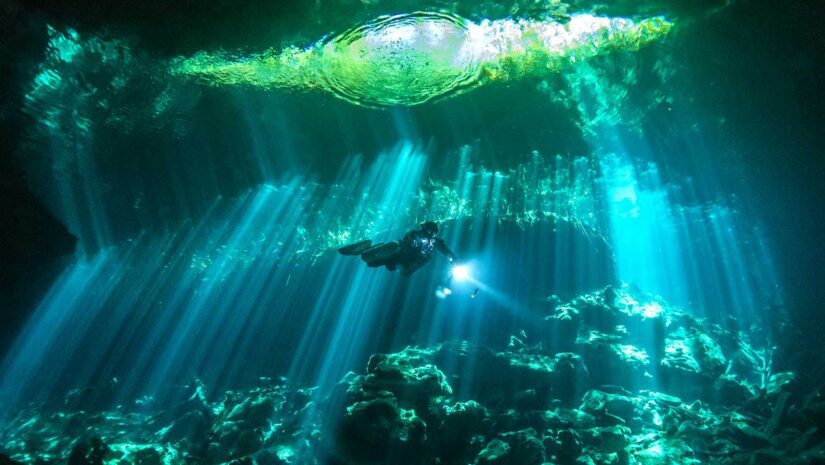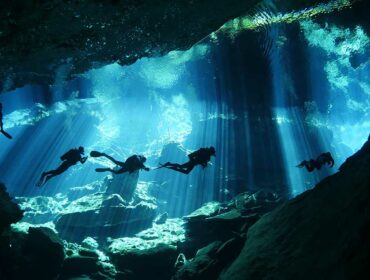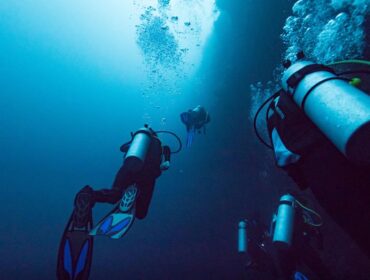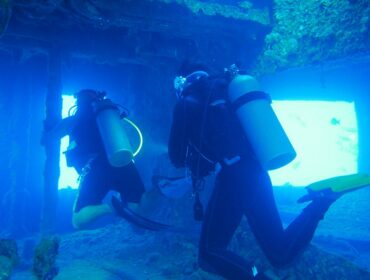The state of Yucatán, Mexico, is home to some of the most beautiful and intricate underwater caves and caverns. These are accessible through entry points or sinkholes known as cenotes (underwater caves). Cenotes (pronounced say-noh-tays) are a type of freshwater-filled limestone sinkhole. These natural wonders connect with other underlying cave systems that can be explored for 100 kilometers or more.
The famous cenotes of the Yucatan peninsula in Mexico are filled with magical history around how they were formed and what they were used for. Today, tourists flock to Mexico to take selfies or scuba dive at the beautiful cenotes. We will review how they were formed and all the information you need to scuba dive there.
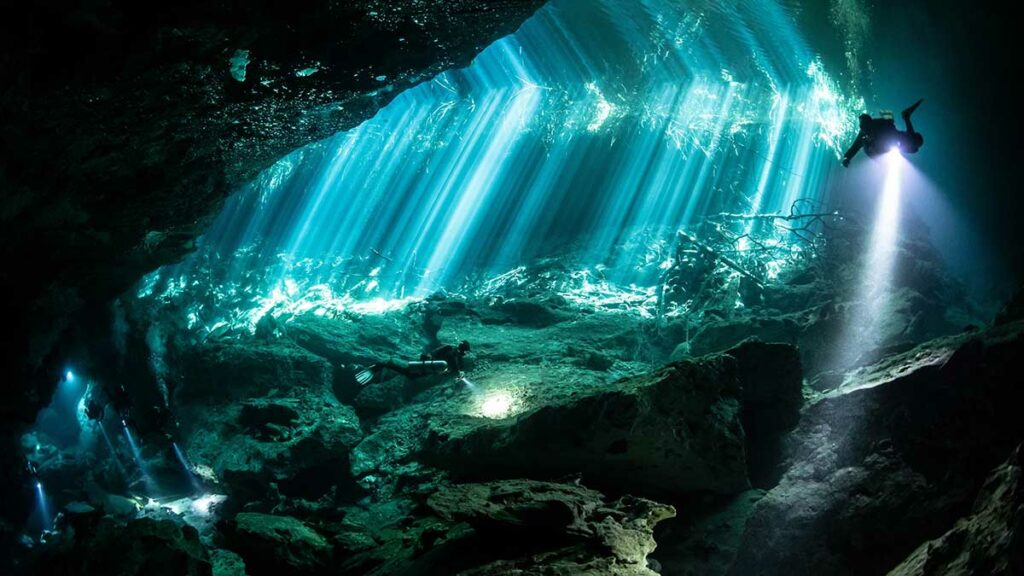
What are cenotes?
So, what is a cenote? A cenote is a sinkhole that formed naturally from collapsing limestone bedrock. The collapsing bedrock exposes underground water. The vast majority of cenotes are in the Yucatan peninsula of Mexico, which is estimated to have around 10,000 cenotes across the area, however the cenotes spread as far as Belize and Guatemala in fewer numbers.
History of cenotes: How they formed
The ancient Mayans commonly used the cenotes as their water source, but they were sometimes also used for sacrificial offerings. But how were the magical Mexican cenotes formed?
Many years ago, the area to the southeast of Mexico was just a seawater-covered coral reef. Over time, the sea levels dropped, which exposed the barrier, and eventually, it died and became a tropical forest. After the last ice age, rainfall began in the area, and the rainwater mixed with carbon dioxide was released into the atmosphere. This made carbonic acid, which became more acidic when it came into contact with the soil on the ground.
The soil has high levels of decomposing organic matter, so more carbonic acid was created, which had a corrosive effect. The mixture of salt and fresh water also took a toll on the limestone rock, and holes began to form over time. These holes grew in size over time and even formed tunnels and passages that linked them. This is what we now call the cenotes.
Types of cenotes
Here are the main types of cenotes:
Open cenotes
Open cenotes are the type that most people recognize. They are surrounded by vegetation and are populated by numerous fauna. This type of cenote is found in the middle of wetlands or within mangroves and is one of the oldest cenotes.
Semi-open cenotes
A semi-open cenote is well recognized for its “pitcher” shape. They were formed by a small opening in the top of the cenote, and the diameter of the cenote increases considerably internally, especially where the water surface is and continues to get wider below. You must go through the upper cavern to get inside a semi-open cenote.
Closed cenotes
Closed cenotes are the youngest type of cenote. They are circular and closed by a vault. Closed cenotes may or may not have openings on the surface that allow sunlight inside. You can access these through passages, caves, or tunnels found at the air level, but accessing a closed cenote depends on whether the water level is safe. Stalagmites and stalactites are found in large quantities in closed cenotes.
Deep open cenotes
Deep cenotes are the most popular amongst tourists because they are open and cylindrical and have high vertical walls. The Sacred Cenote of Chichen Itza is a deep open cenote and is the most famous worldwide.
Most Famous Cenotes in Mexico
There are over 3,000 cenotes (caves) in the Yucatán Peninsula, with only 1,400 being studied and recorded. These cenotes are located between Cancun and Tulum and The Riviera Maya. The Riviera Maya has the world’s three longest-running underwater cave systems. Sistema Ox Bel Ha (270.2 km), Sistema Nohoch Nah Chich (67 km), and Sistema Dos Ojos (82.47 km).
Cenotes were once sacred places of the Mayans, as they were said to represent entrances to the underworld (known as Xibalba). Their natural beauty is best described as crystal clear turquoise waters with sunlight reflecting stalactites and stalagmites. These are genuinely enigmatic works of art that scuba divers worldwide can’t help but explore.
Listed below are five of the most notable cenotes of the Riviera Maya:
Cenote Chac Mool
About 22 kilometers south of Playa Del Carmen and across Puerto Aventuras lies the Chac Mool Cenote. Chac Mool (the “Claw of the Jaguar”) has two entries, both leading to a relatively large cavern with a lot of natural light entering from the opening. This cavern leads to a Dome Room. Here, a portion of the ceiling has collapsed under an air dome where divers can surface to admire many beautiful stalactites and some fossils. Chac Mool is the perfect spot for novice cavern divers since the maximum depth is about 12 meters (36 feet).
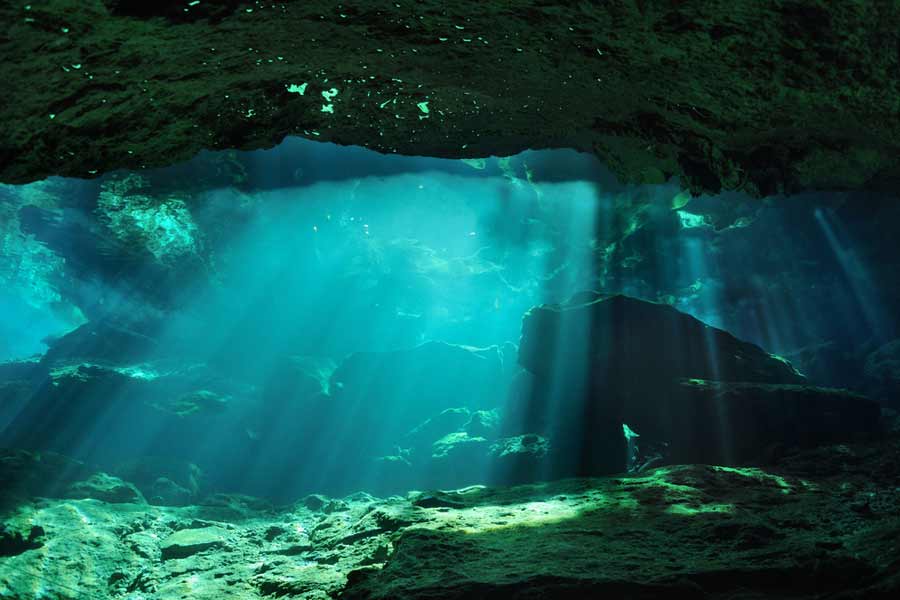
Cenote Kukulkan
A couple hundred feet away from Cenote Chac Mool is another entrance to the Chac Mool system, called Cenote Kukulkan. During sunny days on the Kukulkan side, you can witness a fantastic light show as sunlight reflections create rainbow colors that reach toward the ceiling.
Cenote Dos Ojos
This famous cenote is one kilometer south of Xel-Ha and roughly 48 kilometers from Playa del Carmen. The name “Dos Ojos” means “two eyes” and is derived from the two circular-shaped cenotes that are located very close to each other.
In the 1980s, the Dos Ojos and Nohoch Nah Chich cave systems were discovered through a competition involving two exploration teams that aimed to determine the longest-running underwater cave system in the world.
Two dives are conducted in Dos Ojos. The first starts in the first eye (situated in the east) and progresses through a crystal-clear freshwater cavern leading to the second eye (located in the west). The second dive is darker into a series of rooms and passages underneath an air-filled “bat cave,” which receives very little sunlight. This dive features passageways filled with beautiful and fragile speleothems.
With about 60 kilometers of explored length and connections to over 25 cenotes, Dos Ojos is one of the most extended systems in the Yucatán Peninsula. It’s also an excellent cenote for non-divers, as you can snorkel through the shimmering caves.
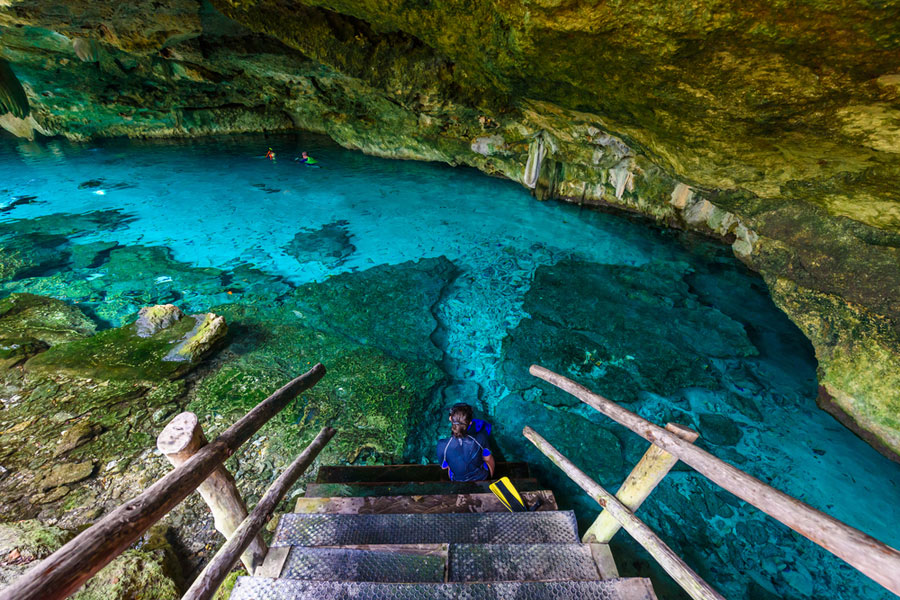
Cenote Taj Mahal
About 29 kilometers south of Playa del Carmen are four interconnected cenotes with much to offer both cavern and cave divers. One of the most beautiful cenotes in The Riviera Maya, the Cenote Taj Mahal boasts a cavern filled with light streaming through holes in the ceiling. As the freshwater creates a distinct layer over the salt water, haloclines appear in deeper areas and create an interesting mirror-like effect.
Gran Cenote
One of the most popular cenote sites in The Riviera Maya, Gran Cenote is part of Sistema Sac Actun. Ladder steps lead to a half-moon-shaped cenote decorated with small passages and openings. Explorers will enjoy a spectacular array of large stalagmites, stalactites, and columns by sticking their faces into the water without diving in. Reasonable buoyancy control is required if diving here, as the walls are heavy with the formations. The maximum depth is said to be 21 meters (70 feet).

Diving in cenotes: what you need to know
Different options are available for divers wanting to scuba dive in the cenotes. Some offer open water divers, some offer cavern dives, and some offer cave dives. Here is the difference:
Open Water dives
As many cenotes are not caves or have tunnel systems, they offer the opportunity to make open water dives, and some have shallow, pool-like conditions that are suitable for confined water dives, too. This means it is possible to take courses at the cenotes and make open water dives in shallow cenotes or deeper cenotes that offer the depth in which you are certified to dive without having any cave diving experience.
Cave diving
A cave is usually considered a cave when it has no sign of natural light, it has narrow passages, and it is more profound than 60ft, or it’s over 200ft from the entrance. Cave diving is highly technical and requires special planning and risk management training. Certified and experienced cave divers will find many exciting options to explore the deep caves and extensive tunnel systems at the cenotes.
Cavern diving
A cavern differs from a cave in that it will have ambient light available and is close to open water. This ensures swimming out and getting to the surface in an emergency is easy. Some dive centers in the Yucatan peninsula offer divers the chance to explore caverns within the cenotes without entering a cave. The training level depends on the cenote and the dive center, but an Advanced Open Water diver certification is adequate for many, although you might need to prove a minimum number of logged dives, too.
Conclusion
The cenotes are fascinating and unique and an exhilarating scuba diving experience. Book your dives before you get there and discover what certifications and knowledge you need for your desired cenotes. With so many divable cenotes, there is an option for every level of diver.

